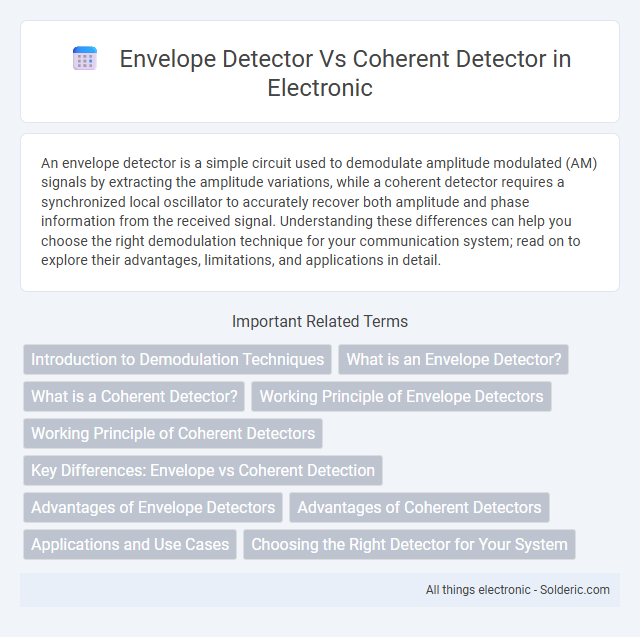An envelope detector is a simple circuit used to demodulate amplitude modulated (AM) signals by extracting the amplitude variations, while a coherent detector requires a synchronized local oscillator to accurately recover both amplitude and phase information from the received signal. Understanding these differences can help you choose the right demodulation technique for your communication system; read on to explore their advantages, limitations, and applications in detail.
Comparison Table
| Feature | Envelope Detector | Coherent Detector |
|---|---|---|
| Principle | Demodulates AM signals by detecting signal envelope | Demodulates signals using a synchronized carrier reference |
| Complexity | Simple, low-cost circuit | Complex, requires carrier synchronization |
| Signal Requirement | Works with AM signals having a strong carrier component | Works with AM, SSB, CW, and PSK signals |
| Performance | Less accurate, affected by noise and distortion | High accuracy, better noise immunity |
| Carrier Recovery | No carrier recovery needed | Requires accurate carrier phase and frequency recovery |
| Applications | AM radio receivers | Digital communication, advanced modulation schemes |
| Output | Envelope of the modulated signal | Baseband signal with minimized distortion |
Introduction to Demodulation Techniques
Envelope detectors offer a simple, cost-effective method for demodulating amplitude modulated (AM) signals by extracting the signal envelope without requiring carrier synchronization. Coherent detectors, requiring precise carrier phase and frequency alignment, provide superior performance in demodulating AM signals, especially under low signal-to-noise ratio conditions. The choice between envelope and coherent detection depends on factors such as system complexity, power consumption, and desired sensitivity in communication receivers.
What is an Envelope Detector?
An envelope detector is a simple circuit used to demodulate amplitude modulated (AM) signals by extracting the envelope, which represents the original information signal. It typically consists of a diode, a resistor, and a capacitor to rectify and smooth the incoming AM signal, providing a crude but effective way to recover the baseband signal without the need for carrier synchronization. Your choice between an envelope detector and a coherent detector depends on the complexity, accuracy, and synchronization requirements of your communication system.
What is a Coherent Detector?
A coherent detector demodulates a signal by multiplying the received modulated wave with a locally generated carrier signal that is phase-locked to the original carrier, enabling accurate retrieval of amplitude and phase information. It requires precise synchronization of frequency and phase between the transmitter and receiver, making it ideal for applications such as quadrature amplitude modulation (QAM) and phase-shift keying (PSK). Compared to an envelope detector, a coherent detector offers superior performance in terms of noise immunity and signal fidelity, especially under low signal-to-noise ratio conditions.
Working Principle of Envelope Detectors
Envelope detectors operate by rectifying the amplitude-modulated (AM) signal and then smoothing it through a low-pass filter to extract the envelope, which corresponds to the original information signal. The diode in the envelope detector allows current flow only during the positive half cycles of the modulated wave, effectively removing the carrier frequency. This method provides a simple, efficient means to demodulate AM signals without requiring carrier synchronization, distinguishing it from coherent detectors which need phase alignment with the carrier.
Working Principle of Coherent Detectors
Coherent detectors operate by mixing the received modulated signal with a locally generated carrier signal that is synchronized in frequency and phase, enabling precise demodulation of the original information. This synchronization allows coherent detectors to recover amplitude, phase, or frequency variations more accurately compared to envelope detectors, which only rectify and filter the incoming signal envelope. Understanding the working principle of coherent detectors helps you achieve higher sensitivity and improved error performance in communication systems, particularly for complex modulation schemes like PSK and QAM.
Key Differences: Envelope vs Coherent Detection
Envelope detectors extract the amplitude variations of a modulated signal without requiring carrier synchronization, making them simpler and cost-effective for demodulating AM signals. Coherent detectors rely on precise carrier phase and frequency synchronization to demodulate signals, resulting in higher accuracy and better performance in noise. Your choice depends on application requirements for complexity, performance, and signal conditions.
Advantages of Envelope Detectors
Envelope detectors offer simplicity and cost-effectiveness, making them ideal for AM radio demodulation where signal complexity is lower. They require less power and hardware compared to coherent detectors, which need a synchronized local oscillator. Your choice for envelope detectors benefits from easier implementation and reliability in noisy environments.
Advantages of Coherent Detectors
Coherent detectors offer superior sensitivity and selectivity compared to envelope detectors, enabling accurate demodulation of weak signals in noisy environments. They provide improved performance for phase and frequency modulation schemes due to their ability to synchronize with the carrier signal. This synchronization results in higher signal-to-noise ratio (SNR) and reduced error rates, making coherent detection ideal for advanced communication systems.
Applications and Use Cases
Envelope detectors are widely used in amplitude modulation (AM) radio receivers due to their simplicity and cost-effectiveness, making them ideal for commercial broadcast and basic communication systems. Coherent detectors, on the other hand, excel in applications requiring higher sensitivity and better noise performance, such as in quadrature amplitude modulation (QAM) and phase-shift keying (PSK) systems widely employed in digital communication and satellite links. The choice between envelope and coherent detectors hinges on the trade-off between complexity and performance, with coherent detection favored in advanced data transmission and envelope detection in straightforward, cost-sensitive scenarios.
Choosing the Right Detector for Your System
Choosing the right detector for your system depends on factors like signal type, complexity, and performance requirements. Envelope detectors excel in simplicity and cost-effectiveness for amplitude modulated signals but may suffer from reduced accuracy in noise. Coherent detectors offer superior sensitivity and accuracy by using a reference signal for demodulation, making them ideal for communication systems demanding high fidelity.
Envelope detector vs coherent detector Infographic

 solderic.com
solderic.com